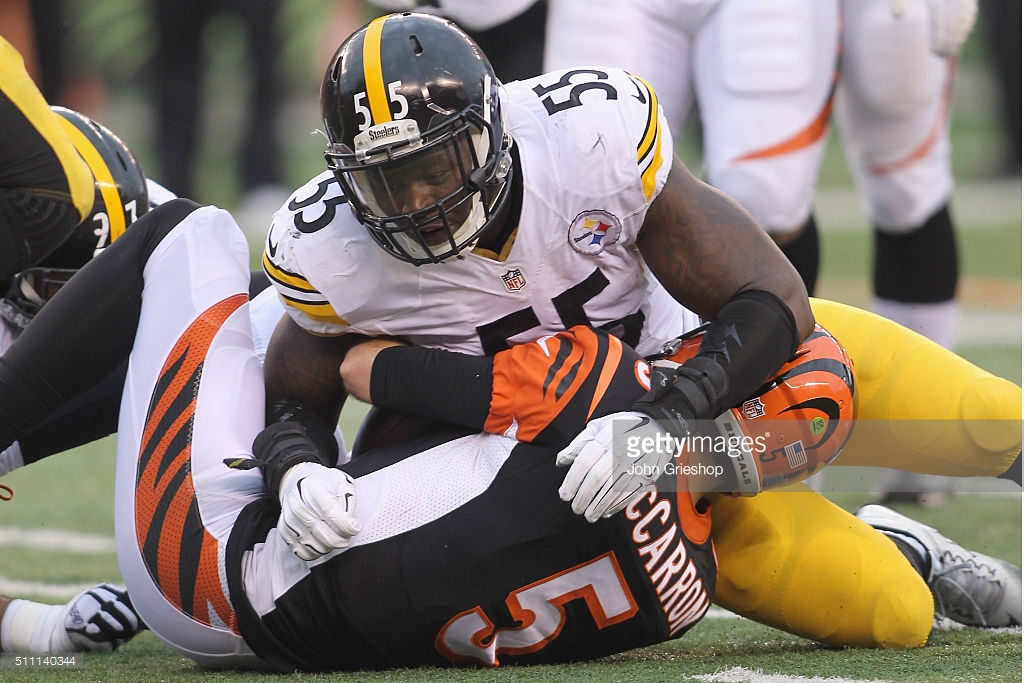After nine years in the NFL, Arthur Moats is ready to move on with life’s work.
Retirement is a decision Moats’ publicly announced last week but considered for the past three years, including prior to his final season with the Pittsburgh Steelers in 2017. Spending part of last season on injured reserve as a member of the Arizona Cardinals allowed for time to reflect on his career and future, pushing him closer to retirement.
A 6th round picks out of James Madison, he hangs up his cleats after an impressive career. The Buffalo Bills took a chance on him with the 178th pick, turning that opportunity into an NFL resume that includes 202 tackles, 16.5 sacks, and 45 starts.
But Moats knew it was time to walk away from the game.
“Once I got hurt and was on injured reserve, it gave me time to really think about everything,” he told me in an interview over the weekend. “Said to myself, if this is 100% what I want to do in terms of retiring. So when I came back in October, November, once I did the injury settlement, I really just started hopping into the media thing and enjoying the family time and seeing what it would be like not playing football.”
Even though Moats won’t be suiting up anymore, odds are good you’ll hear from him this year. He’s jumped into TV and radio, periodically appearing on Steelers Nation Radio. He says there’s talks between he and the team for something full-time but has gotten interest from other outlets and is currently weighing his options.
After four years in Buffalo, Moats was slated to hit free agency for the 2014 season. A reunion with the Bills wasn’t in the cards. Three teams expressed interest in him. There was Cleveland, hiring Mike Pettine to be their head coach, who served as Moats’ DC in Buffalo. There was New England, perennial powerhouse who would go on to win the Super Bowl later that year. Then there was Pittsburgh.
To some, the Steelers would’ve been last on that list. Going to Cleveland meant having the head coach in your corner. New England, on paper, was the best chance to win. But after Mike Tomlin called and spoke to Moats, he was sold.
“The biggest thing in making Pittsburgh the final choice was my comfort level with Coach Tomlin. Me and him being from the same hometown, understanding the type of success that he had, and also the continuity they had with the group in Pittsburgh. From a coaching standpoint versus Cleveland where they had a lot of turnover.”
He admits going to the Steelers over the Patriots had a little something to do with a high school and collegiate mentality of not joining your rivals.
“For me, really deciding Pittsburgh over New England, New England was in my division at the time in Buffalo. I felt like going back to that college mentality that I was loyal to my team and I didn’t want to go to my rival.”
But coming to Pittsburgh had a cost and a risk. Literally. Moats signed a one-year, veteran minimum deal worth $795,000. He took Tomlin at his word that if he came in and produced, the team would agree to an extension the following offseason.
“Coach Tomlin was basically saying, ‘hey, I know you can rush the passer. I remember you doing it. If you come take a chance on us, we’ll take a chance on you. If you come here on a one-year, vet minimum contract we’ll extend you and give you a nicer contract in the future.'”
In 2014, Moats started nine games, picked up four sacks, fourth on the team, and the organization stuck to their promise. He signed a three year, $8 million contract before free agency began.
After a difficult 2019 offseason, Tomlin and the Steelers’ culture has come under fire. Some of it fair, there’s always going to be criticism after a messy divorce like the one the team and Antonio Brown underwent. But Moats defended Tomlin and his record for what he brought as a coach and leader. In Pittsburgh, he grew a better understanding of how to watch tape.
“I remember when I was in Buffalo I watched film from a defensive standpoint. How I would attack a player, or what coverage we’re trying to do. Whereas [Tomlin] showed me how to watch film from an offensive perspective. Basically, saying if we’re running this defense, how is the team going to attack? If you were on offense right now, how would you attack this play? What would give you the most success? So for me, that changed my whole outlook on the game. When we call certain plays, now I know this is a weakness. When we call this play, I know this is what a team is going to be looking to do in terms of attacking. And it ultimately I thought it helped me grow and become a better player because of that.”
Off the field, Moats says Tomlin stressed balance in life, a difficult line for many pro athletes to walk given the pressure of the NFL. And in doing so, it’ll make you a better player.
“As far as off the field, as far as being a man, he taught me that hey, it’s still important to put your family first . Because a lot of times young players like myself at the time, going into my 5th season, you get caught up in I have to strictly put as much time and effort into football as possible. Sometimes you would neglect your family and other things like that. He would always say you have to have that balance because if you neglect your family, ultimately that’s going to hinder you as a player because you’re not going to be able to be all the way here and all the way focused when we need you.”
Though he wasn’t a member of the organization last year, Moats said he never got the sense Tomlin lost the locker room. Former NFL punter Pat McAfee once said coaches only lose the locker room if they lose the “OGs,” the veterans of the group. Based on everything said by Cam Heyward, the fact Ramon Foster re-upped with the team, and the general sense of calm that seems to exist now, it’s fair to say Moats’ assessment is accurate.
In four years as a Steeler, Moats enjoyed his gratest NFL success. He recorded 11.5 sacks, four in each of his first two season. His second QB takeadown while wearing black and gold was the one he cherished the most. It came at Heinz Field in a 43-23 win over the Baltimore Ravens, wrestling Joe Flacco down late in the first half.
It’s the same quarterback he took down as part of his first NFL sack, cleaning up Chris Kelsay’s pressure in an overtime loss to the Ravens in 2010. Moats is sporting #52 here.
But his most memorable moment in Pittsburgh was undoubtedly 2017 win over Baltimore, the AFC North clinching victory a week after Ryan Shazier’s injury that left him paralyzed. Emotional as that week and game was, Moats says it was Shazier’s spirit and positive attitude that kept the locker room intact.
“I remember the only way all of us got through it was because of him. We go and see him when he first got back from Cincinnati. We’re all trying to hold it together, trying to be tough even though we all wanted to break down and cry. And he’s in there smiling, talking about what’s the gameplan for next week, what do they look like on film. And we’re sitting here just, unreal that throughout that whole situation he’s still concerned about the game, he’s still concerned about us being successful. And it was things like that that really motivated us and helped us get through that situation that week in particular.”
The team was able to bring him back the Division Champion T-shirts and hats. They advanced as a team both in record and in unity.
“Then going forward for the rest of the season, it became where all us guys became extremely close. Instead of us hanging out at each others houses, we’re hanging out at the hospital every week. Coming to see him eating with him, fellowshipping with him, support for him.”
Shazier’s recovery, as I’m sure you know, has been nothing short of remarkable. Though he’s been ruled out for this year, placed on Reserve/PUP shortly after the draft, he’s publicly discussed the goal of returning to football.
Fans know Moats nearly as much for his off field work as they do his on field performance. He was one of the most active players in the community and continues to give back. It’s a value instilled by his parents from the beginning.
“It did start with my parents who were both pastors. At the time, every Saturday and Sunday after church we would go to different inner-city communities and hand out loaves of bread. I remember being nervous because we would go to these drug-infested places where you see murders, hear about shootings, stuff like that. You go up and knock on their doors but when they open the door, you give them a loaf of bread and tell them Jesus loves them and that’s it, you see how they let their guard down and be so more welcoming. And ultimately you would make their day. That really stuck with me. When I got to college, I wanted to continue doing something, wanted to continue having a positive impact.”
His contributions are nearly too numerous to list. In college, he got involved in Big Brothers, Big Sisters, connecting with a six year old boy who graduated high school this year. He was nominated for the Walter Payton Man of the Year Award twice, once in Buffalo and again in Pittsburgh, and made a $300,000 donation to his alma mater in 2015. Giving back to JMU was important because, as he puts it, it’s the place that gave him an education, propelled his football career, and where he met his wife Shonda.
For his work in the community and with the media, always someone willing to give a quote win or lose, Pittsburgh named him the winner of their 2016 The Chief Award. An honor that isn’t lost on Moats.
“That was a huge honor. Anytime you’re receiving any type of award named after The Chief, you think about the Chief in general he was a legendary guy not only in Pittsburgh history but sports history in general. Whenever you’re able to receive an award named after someone like that it’s very humbling.”
Art Rooney Sr. wasn’t alive to see him play. But I bet if he envisioned someone who embodied everything it meant to be a Steeler, on and off the field, it would be Arthur Moats.







